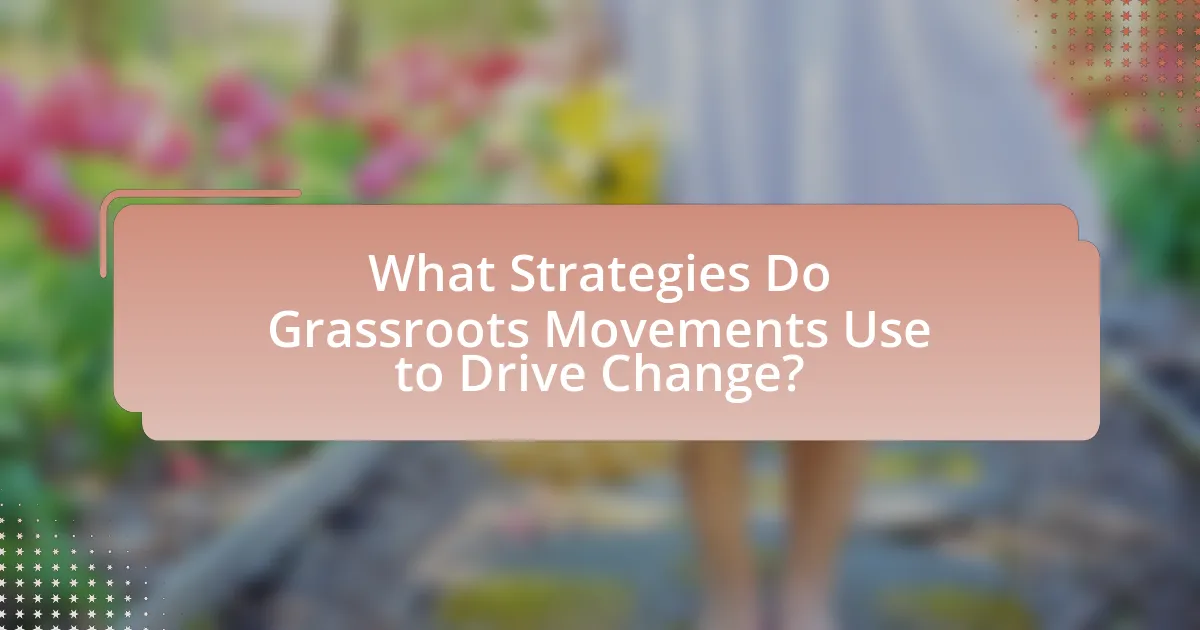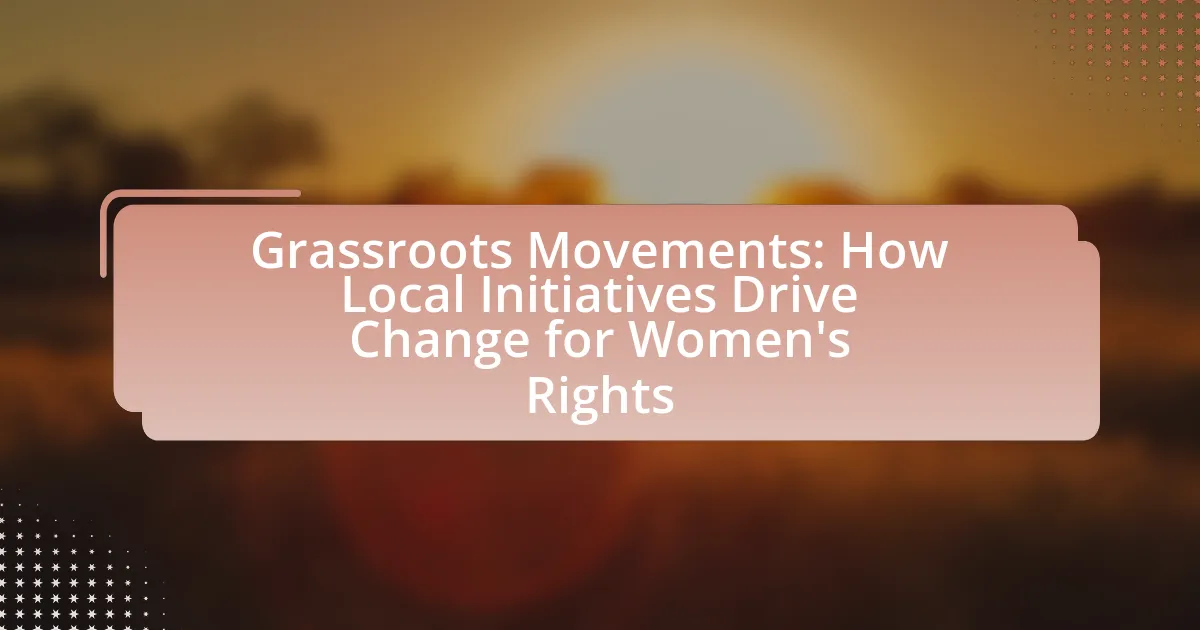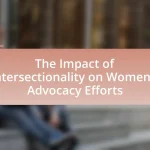Grassroots movements are community-driven initiatives that mobilize individuals at the local level to advocate for women’s rights and social change. This article explores the role of grassroots activism in empowering women, highlighting key characteristics, strategies, and the impact of movements such as the Women’s March and #MeToo. It discusses how local communities engage in advocacy, the challenges faced by these movements, and the importance of education and social media in driving change. Additionally, it provides examples of successful grassroots initiatives and outlines best practices for individuals looking to support women’s rights through local efforts.
What are Grassroots Movements and Their Role in Women’s Rights?
Grassroots movements are community-driven initiatives that mobilize individuals at the local level to advocate for social change, including women’s rights. These movements empower women by raising awareness about gender inequality, advocating for policy changes, and providing support networks. For example, the Women’s March, which began in 2017, mobilized millions globally to advocate for women’s rights and social justice, demonstrating the power of grassroots activism. Additionally, studies show that grassroots organizations often lead to significant legislative changes, such as the passing of laws aimed at protecting women’s rights in various countries.
How do grassroots movements initiate change for women’s rights?
Grassroots movements initiate change for women’s rights by mobilizing local communities to advocate for policy reforms and social awareness. These movements often begin with individuals or small groups identifying specific issues affecting women’s rights, such as gender-based violence or unequal pay. For instance, the #MeToo movement, which started as a grassroots initiative, raised global awareness about sexual harassment and led to significant legislative changes in various countries. Research indicates that grassroots activism can effectively influence public opinion and policy, as seen in the 2017 Women’s March, which drew millions worldwide and highlighted issues like reproductive rights and workplace equality.
What are the key characteristics of grassroots movements?
Grassroots movements are characterized by their community-driven nature, emphasizing local participation and collective action. These movements typically arise from the needs and concerns of ordinary people rather than top-down directives from established organizations or authorities. They often focus on social change, mobilizing individuals to advocate for specific issues, such as women’s rights, through grassroots organizing, which includes community meetings, rallies, and social media campaigns.
Additionally, grassroots movements are marked by their inclusivity, aiming to represent diverse voices and perspectives within the community. This characteristic fosters a sense of ownership among participants, as they actively contribute to the movement’s goals and strategies. Evidence of their effectiveness can be seen in various historical contexts, such as the Women’s March in 2017, which mobilized millions globally to advocate for women’s rights and social justice, demonstrating the power of collective grassroots action.
How do local communities mobilize for women’s rights?
Local communities mobilize for women’s rights through grassroots organizing, advocacy, and coalition-building. These efforts often involve forming local groups that raise awareness about women’s issues, such as gender-based violence and economic inequality. For instance, organizations like the Women’s March have demonstrated how community members can unite to advocate for policy changes and social justice. Additionally, local communities often leverage social media platforms to amplify their messages and connect with broader movements, enhancing their visibility and impact. Research indicates that grassroots movements can lead to significant policy changes, as seen in various countries where local activism has successfully influenced legislation on women’s rights.
Why are grassroots movements essential for women’s rights?
Grassroots movements are essential for women’s rights because they empower local communities to advocate for change and address specific issues affecting women. These movements often arise from the lived experiences of women, allowing them to identify unique challenges and mobilize support effectively. For instance, the Women’s March in 2017, which began as a grassroots initiative, highlighted issues such as reproductive rights and gender equality, demonstrating the power of collective action. Additionally, grassroots movements have historically led to significant policy changes, such as the passage of the Violence Against Women Act in the United States, which was influenced by local advocacy efforts. This direct engagement fosters a sense of ownership and accountability, ensuring that women’s voices are heard and prioritized in the fight for equality.
What impact do grassroots movements have on policy changes?
Grassroots movements significantly influence policy changes by mobilizing community support and raising awareness about specific issues. These movements often highlight social injustices and advocate for reforms, leading to increased public pressure on policymakers. For instance, the Women’s March in 2017 galvanized millions to advocate for women’s rights, resulting in legislative discussions around gender equality and reproductive rights. Research indicates that grassroots activism can lead to tangible policy outcomes, as seen in the successful push for the Violence Against Women Act in the United States, which was heavily supported by grassroots organizations. This demonstrates that grassroots movements can effectively shape policy agendas and drive legislative change.
How do grassroots movements empower women at the local level?
Grassroots movements empower women at the local level by fostering community engagement and providing platforms for women’s voices. These movements often mobilize resources and support networks that enable women to advocate for their rights and address local issues, such as access to education, healthcare, and economic opportunities. For instance, organizations like Women for Women International have demonstrated that local initiatives can lead to significant improvements in women’s social and economic status, as evidenced by their programs that have helped over 500,000 women in conflict-affected areas gain skills and confidence to participate in their communities. This empowerment is further reinforced by the collective action and solidarity that grassroots movements cultivate, allowing women to challenge systemic inequalities and influence local policies effectively.

What Strategies Do Grassroots Movements Use to Drive Change?
Grassroots movements use strategies such as community organizing, advocacy, coalition building, and social media engagement to drive change. Community organizing involves mobilizing local individuals to address specific issues, fostering a sense of ownership and empowerment. Advocacy efforts focus on influencing policy decisions through lobbying and public campaigns, exemplified by movements like the Women’s March, which brought attention to women’s rights issues globally. Coalition building connects various groups to amplify their voices and resources, enhancing their impact. Social media engagement allows grassroots movements to reach wider audiences quickly, facilitating awareness and support, as seen in campaigns like #MeToo, which highlighted sexual harassment and assault. These strategies collectively enable grassroots movements to effect significant social and political change.
How do grassroots organizations engage their communities?
Grassroots organizations engage their communities by fostering local participation and mobilizing collective action. They achieve this through community meetings, workshops, and outreach programs that encourage dialogue and collaboration among residents. For instance, organizations like the Women’s March leverage social media to organize events and disseminate information, effectively reaching diverse audiences and amplifying community voices. This approach not only builds awareness around women’s rights issues but also empowers individuals to take action, as evidenced by the significant turnout at grassroots-led events, which often attract thousands of participants advocating for change.
What role does education play in grassroots initiatives?
Education plays a crucial role in grassroots initiatives by empowering individuals with knowledge and skills necessary for advocacy and community organizing. It equips participants with the ability to understand their rights, mobilize resources, and effectively communicate their needs. For instance, programs that educate women about legal rights and health issues have been shown to increase participation in local governance and decision-making processes, thereby enhancing the effectiveness of grassroots movements. Research indicates that educated individuals are more likely to engage in civic activities, which is essential for the success of initiatives aimed at driving change for women’s rights.
How do grassroots movements utilize social media for advocacy?
Grassroots movements utilize social media for advocacy by leveraging platforms to mobilize supporters, disseminate information, and amplify their messages. These movements create online campaigns that engage users through hashtags, shareable content, and targeted messaging, which can rapidly spread awareness about issues related to women’s rights. For instance, the #MeToo movement gained significant traction on social media, allowing individuals to share their experiences and connect with a larger community, thereby increasing visibility and support for the cause. Research indicates that social media can enhance grassroots efforts by facilitating real-time communication and fostering a sense of community among activists, which is crucial for driving social change.
What challenges do grassroots movements face in advocating for women’s rights?
Grassroots movements face significant challenges in advocating for women’s rights, including limited funding, lack of visibility, and resistance from established power structures. Limited funding restricts their ability to mobilize resources effectively, as many grassroots organizations operate on tight budgets and rely on small donations or volunteer efforts. Lack of visibility hampers their outreach and impact, as mainstream media often overlooks these movements, making it difficult to gain public support and awareness. Additionally, resistance from established power structures, including government entities and traditional societal norms, can lead to pushback against their initiatives, undermining their efforts to create meaningful change. These challenges collectively hinder the effectiveness and sustainability of grassroots movements in promoting women’s rights.
How do funding and resources affect grassroots initiatives?
Funding and resources significantly enhance the effectiveness and reach of grassroots initiatives. Adequate financial support allows these initiatives to implement programs, organize events, and mobilize community members, which is crucial for driving change. For instance, a study by the National Committee for Responsive Philanthropy found that organizations with stable funding are 3.5 times more likely to achieve their goals compared to those without. Additionally, access to resources such as training, technology, and networking opportunities empowers grassroots movements to develop sustainable strategies and foster collaboration, ultimately leading to greater impact in advocating for women’s rights.
What obstacles do grassroots movements encounter from authorities?
Grassroots movements encounter significant obstacles from authorities, including repression, lack of recognition, and legal challenges. Repression can manifest as police violence, surveillance, or intimidation tactics aimed at discouraging participation. For instance, during protests advocating for women’s rights, authorities may deploy law enforcement to disperse crowds or arrest activists, as seen in various global movements. Lack of recognition often leads to insufficient support or funding, hindering the movement’s ability to mobilize effectively. Legal challenges may involve restrictive laws that limit assembly or speech, which can stifle grassroots efforts. These obstacles collectively impede the progress of grassroots movements striving for change in women’s rights.
What Examples Illustrate the Impact of Grassroots Movements on Women’s Rights?
Grassroots movements have significantly impacted women’s rights through various initiatives and campaigns. One prominent example is the Women’s March, which began in 2017, mobilizing millions globally to advocate for women’s rights, reproductive rights, and against gender-based violence. This movement not only raised awareness but also influenced political discourse and led to increased female representation in government.
Another example is the #MeToo movement, which started as a grassroots initiative to combat sexual harassment and assault. It empowered countless women to share their experiences, resulting in widespread societal change and legal reforms aimed at protecting women’s rights in workplaces.
Additionally, the Black Women’s Health Imperative, founded in 1983, focuses on addressing health disparities affecting Black women. This grassroots organization has successfully advocated for policy changes and increased funding for health programs tailored to the needs of Black women, illustrating the direct impact of local initiatives on women’s rights.
These examples demonstrate how grassroots movements can mobilize communities, influence policy, and drive systemic change in women’s rights.
What are some successful grassroots movements focused on women’s rights?
Successful grassroots movements focused on women’s rights include the Women’s March, the #MeToo movement, and the Suffragette movement. The Women’s March, which began in 2017, mobilized millions globally to advocate for women’s rights and social justice, highlighting issues such as reproductive rights and gender equality. The #MeToo movement, initiated in 2006 and gaining prominence in 2017, empowered individuals to speak out against sexual harassment and assault, leading to significant cultural and legislative changes. The Suffragette movement, active in the late 19th and early 20th centuries, successfully fought for women’s right to vote, culminating in the passage of the 19th Amendment in the United States in 1920. Each of these movements demonstrates the power of grassroots activism in advancing women’s rights through collective action and advocacy.
How did the #MeToo movement exemplify grassroots activism?
The #MeToo movement exemplified grassroots activism by empowering individuals to share their personal experiences of sexual harassment and assault, thereby creating a collective voice for change. This movement originated on social media platforms, where survivors, particularly women, utilized hashtags to raise awareness and foster community support, demonstrating the power of decentralized, community-driven efforts. The widespread participation, with millions of people sharing their stories globally, illustrates how grassroots initiatives can mobilize public sentiment and influence societal norms regarding women’s rights and safety.
What lessons can be learned from the Women’s March?
The Women’s March teaches the importance of collective action in advocating for women’s rights. This global event, which began in January 2017, mobilized millions of participants across various cities, demonstrating that grassroots movements can effectively raise awareness and influence policy. The march highlighted the power of intersectionality, emphasizing that diverse voices and experiences are crucial in the fight for equality. Additionally, it showcased the effectiveness of social media in organizing and amplifying messages, as platforms like Twitter and Facebook played significant roles in rallying support and spreading information. These lessons underscore the potential of local initiatives to drive broader societal change for women’s rights.
How can individuals support grassroots movements for women’s rights?
Individuals can support grassroots movements for women’s rights by actively participating in local initiatives, donating to organizations that advocate for women’s rights, and amplifying the voices of marginalized women. Participation in local initiatives, such as attending rallies or volunteering for campaigns, directly contributes to the visibility and effectiveness of these movements. Financial contributions to organizations like the Women’s March or local shelters provide essential resources for advocacy and support services. Additionally, using social media platforms to share stories and information about women’s rights issues helps raise awareness and mobilize community support. Research indicates that grassroots movements can significantly influence policy changes, as seen in the success of the #MeToo movement, which highlighted the prevalence of sexual harassment and led to legislative reforms in various states.
What actions can individuals take to contribute to local initiatives?
Individuals can contribute to local initiatives by volunteering their time and skills to support community projects. Engaging in activities such as organizing events, participating in clean-up drives, or offering professional expertise can significantly enhance the effectiveness of local initiatives. For instance, according to a report by the Corporation for National and Community Service, volunteers contribute an estimated $184 billion annually to the U.S. economy, demonstrating the tangible impact of individual involvement in community efforts. Additionally, individuals can advocate for local initiatives by raising awareness through social media or community forums, thereby mobilizing others to join the cause.
How can community involvement enhance the effectiveness of grassroots movements?
Community involvement enhances the effectiveness of grassroots movements by fostering local ownership and increasing participation in initiatives. When community members actively engage, they contribute diverse perspectives and resources, which strengthens the movement’s relevance and adaptability to local needs. For instance, research by the Stanford Social Innovation Review highlights that grassroots movements with strong community ties often achieve higher levels of mobilization and sustained engagement, leading to more significant policy changes. This direct connection between community involvement and movement success is evident in various women’s rights initiatives, where local advocacy has resulted in tangible legislative reforms.
What are best practices for engaging in grassroots movements for women’s rights?
Best practices for engaging in grassroots movements for women’s rights include building a strong community network, utilizing social media for outreach, and fostering inclusive participation. A strong community network allows for shared resources and collective action, which is essential for mobilizing support. Social media platforms have proven effective in raising awareness and organizing events, as seen in movements like #MeToo, which gained global traction through online engagement. Inclusive participation ensures diverse voices are heard, enhancing the movement’s legitimacy and effectiveness, as demonstrated by the Women’s March, which brought together individuals from various backgrounds to advocate for women’s rights.


